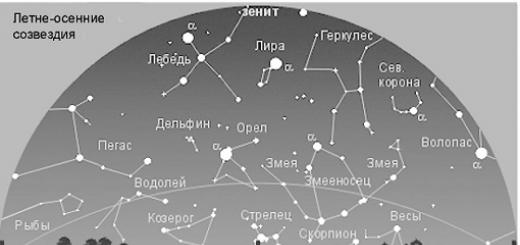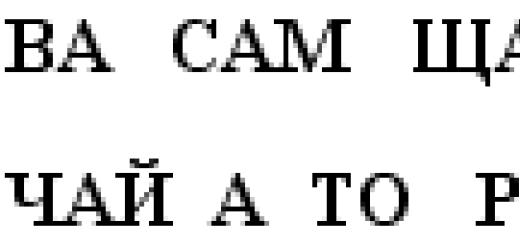letters - sounds vowels
a - a e– й΄ I– th ΄
I - a e a
e - e yo– th ΄ Yu– й΄
e - e o u
o - o 1. at the beginning of the word - I measles
ё - o 2. in the middle of the word after
y - y separating b and b signs - under yo m, seven Yu
yu - u 3. in the middle of a word after a vowel - cheerful I ,
and - i by yo m
s - s
10 – 6
Transcription is a recording of the sound of speech.
Transcription is written in square brackets using additional characters:
[y΄] - the sound of yot, written in letters in writing th or "cunning" e, yo, yu, i: hedgehog - [yosh];
[΄] - designation of the softness of the consonant: sang - [p΄el];
[־] - designation of a long consonant: quarrel - [litter].
Ways to designate the sound [w΄]:
sorrel - [sh΄iv΄el΄]; sch
carter - [wosh΄ik΄]; zch
man - [man]. zhch
Methods for designating sound [ts]:
swim - [merchant]; ts [ts]
fights - [d΄ir΄otsa]. ts
Take note!
1. Voiced consonants at the end of words and before deaf consonants are stunned: mushroom - [g΄ip], fairy tale - [tale].
2. Deaf consonants before voiced voiced: bring down - [zb΄it΄].
3. The softness of consonants is indicated by letters e, e, u, i, and, s: rural - [s΄el΄sk΄y΄].
4. According to the norms of pronunciation with confluence of consonants in some words, sounds [ c], [d], [l], [t] are not pronounced: feeling - [feelings], heart - [s΄erce], sun - [sontse], domineering - [powerful].
Remember! All voiceless consonants are in the phrase:
Sound letter analysis of the word
Write down the word.
Take a red pencil and underline all the vowels in the word.
Divide the word into syllables with a vertical line.
Call the word, highlighting the stressed syllable with your voice. Put an accent. Remember, the stress is on the vowel of the syllable.
Draw a diagram of the word.
Describe each sound and color the diagram.
For example, I BLO N K A ZH I R A F
LETTER
[ SOUND ]
VOWEL CONSONANT
IMPACT - UNSTRIKED VOICED - DEAF
SOFT - HARD
Parts of speech
Independent
| Noun | Adjective | Verb | Numeral | Pronoun | Adverb |
| subject | object attribute | action of the subject | the number, quantity and order of things in counting | does not name, but indicates | sign of action, state |
| who? what? | which? which? which? which? | what to do? what to do? | How many? which the? | who? what? whose? | as? when? where? where? why? |
| notebook, maple blizzard, fog, rabbit, Trezor | smart, smart, smart, smart | read, read, read | five, three, seventh | I we he she it they | happy yesterday at the top from afar willy-nilly |
Service
Service parts of speech are used only together with independent ones and are not members of the sentence.
Noun - is the part of speech that answers questions who? andwhat? and calls
specific items ( desk , branch )
natural phenomena ( frost , rain )
living things ( sparrow , kids )
developments ( rally , holiday )
process, action cultivation , the fall )
abstract concepts ( love , joy )
animate nouns inanimate nouns
who? what?
bird wind
(generalized name homogeneous ( individual name living beings and objects
objects, phenomena) to distinguish them from others)
nightingale russia
the charm of the Ob
Tolstoy's victory
Adjective is the part of speech that means object sign and answer questions
which? linquisitive– masculine gender (m.s.)
which?healthy - feminine (feminine) singular (singular)
which?transparent - neuter gender (cf. p.)
which? clean --plural (plural)
whose?Svetin, daddy
Verb is the part of speech that means action of objects and answer questions what to do?dream
what to do?make
1. initial form verb - indefinite form
what to do? write, carry
what to do? write, bring
2. There are perfect and imperfect .
Perfect view(action has already been done, completed or will be completed) - what will do? – will work, will draw.
Imperfect view(action not completed) - what does? – works, draws.
3. Verbs changeat times :
The present time The action takes place at the moment of speaking.
what do? – I read, see;
Future time- the action will take place after the moment of speech.
what I will do? – read, see, will talk;
Past time The action took place before the moment of speech.
what did? – was reading, what did? – saw.
4. Change on numbers– unit - I keep, pl. hours - are holding.
5. In singular past tense change on childbirth:
Male genus (m.r) - he glittered
Female gender (feminine) - she is glittered
Average genus (cf.r) - it glittered
| Sentence | ||
| according to the purpose of the statement | by intonation |
|
| narrative (story, narration) | Non-exclamatory | |
| exclamatory | ! |
|
| interrogative | Non-exclamatory | ? |
| exclamatory | ? ! |
|
| Incentive (order, request) | Non-exclamatory | |
| exclamatory | ! |
|
The grammatical basis of the sentence
(main members of the sentence)
| Subject ( underlying proposal) | Predicate (what is said about the subject )
|
| - this is main member sentence, which names who or what the sentence is talking about. | - this is the main member of the sentence, which is associated with the subject and names what the object does, its state, its feelings. |
| - answers the questions who? or what? | - answers questions about what does? what have you been doing? what will do? what? |
| - emphasized with one line | - emphasized by two lines |
| - can be expressed: noun I heard a quiet music. pronoun All gathered in the hall. combination of words Mom recently had birthday. | - can be expressed: verb Fun sang roosters. noun My sister artist. adjective Night stellar. short adjective Our Katya neat.
|
| - there can be one subject Night. Late autumn.
| - there can be one predicate Freezes. write down in a notebook. |
Secondary members of the sentence
They serve to explain, clarify, supplement the main and other minor members and are grammatically subordinate to them.
| Circumstance | Definition | Addition |
| - minor member of the sentence, which means circumstances committing action; explains the predicate. | - a minor member of the sentence, which means sign subject and answers the questions: what? which? which? which? whose? whose? whose? whose? | - a secondary member of the sentence, which answers the questions: whom? what? to whom? what? what? by whom? how? about whom? about what? Usually the object is associated with the predicate: it indicates what object or phenomenon the action is directed to. |
| circumstances of the course of action Masha reads expressively. circumstances of time It was pouring rain at night. circumstances of the place Buds swelled on the poplars. circumstances reasons The ground is damp from the rain. target circumstance I went to the store for bread. | Green leaves rustle on the branches. Foliage (what?) Green. Olya took her mother's umbrella. Umbrella (whose?) Mother's. |
|
| In the last lesson, we learned about the definition. Learned (about what?) about the definition. The students listen to the teacher. Listen to (whom?) Teachers. |
||
| – underlined – dot dash | - underlined with a wavy line | - underlined - dash, dash |
| Change the form of a word | Pick a single word |
| 1. One is many Tr a va-tr a you W a gi-sh a G Cm about trill, cm about third - cm about trite | 1. Word - object (noun) Tr e shield - tr e sk T e lot - t yo many To about Rmushka -k about rmit Toabout
ver - toabout
vrick |
UNSTRESSED VOF IN THE ROOT OF THE WORD
Verification algorithm
1.
Read the word, put the stress.
2.
Determine in which part of the word there is an unstressed vowel. Select the root and the unstressed vowel.
3.
To check the vowel of the root, change the word or pick up a single root so that the vowel being checked is under stress.
4.
Write in the word the same vowel as in the test.
5.
Define the spelling.
Procedure for debiting, 1st class:
1. Read the sentence. Understand it.
2. Read clearly the first word of the sentence as it is written.
3. Repeat the word, check with what is printed. Remember how the word is spelled.
4. Write down the word, clearly dictating it to yourself.
5. Check yourself: read what is written and compare it with what is printed.
6. Write off the remaining words of the sentence in the same way.
Phonetic parsing plan
1. Divide the word into syllables.
2. Show the place of stress.
Vowels are sounds that, unlike consonants, arise during the formation of a tone - without the participation of noise.
In addition, unlike consonants, vowels are able to form a syllable and participate in the formation of stress.
Vowel sounds in the Russian language are very important: in addition to participating in semantic discrimination, they are pivotal for us in determining the rhythmic structure of a word and its boundaries.
In Russian, vowel sounds perform the following functions: they participate in the construction of a word, they can distinguish words, create rhythm - form stress, participate in the formation of intonation (including emotional - “How she is crying!” - we say when we want to express our especially cordial).
The basis of vowel sounds is tone. Therefore, vowel sounds are clearly audible, they can be stretched in duration (lost in the forest, we call "au-au-au!").
The sounds of speech in writing are square brackets. This is a transcription. It is not customary to write in transcription capital letters and put punctuation marks.
10 letters are designed to denote vowel sounds and are conventionally called vowels (a, y, o, s, e, i, u, e, i, e).
There are six vowels - [A] [O] [U] [S] [I] [E].
In Russian, there are more vowels than vowels, which is associated with the peculiarities of the use of the letters i, u, e, ё (iotated or tricky vowels).
The sound meaning of the letters e, e, y, i.
1. Letters e, e, u, i can represent two sounds: [ye], [yo], [yu], [ya]. This happens in the following cases:
at the beginning of a word: for example, spruce - [ye] l, hedgehog - [yo] w, yula - [yu] la, pit - [ya] ma; after a vowel sound: washes - mo [ye] t, sings - po [yo] t, give - yes [yu] t, bark - la [ya] t; after dividing b, b: eat - eat [ye] m, drink - drink [yo] t, pour - l [yu] t, zealous - ry [ya] ny.
In addition, after the separation b two sounds will be denoted by a letter and: nightingales - nightingale [yi].
2. The letters e, e, u, i indicate the softness of the previous consonant in a position after consonants, paired in hardness-softness: fur - [m′eh], carried - [n′os], hatch - [l′uk], crumpled - [m′al].
One of the most difficult sections for schoolchildren and students in the Russian language is phonetics. Quite often, students make mistakes in words, characterization of certain sounds, phonemes. But in many ways, knowledge of phonetics is the key to competent and cultural speech. Therefore, a lot of attention should be paid to such an issue as sounds. Today we are interested in the letters that they represent will also be discussed in our article. We will not ignore and General characteristics sound system of our language.
Sounds or letters?
To begin with, let's figure out what exactly we will describe in this article. It is worth noting that many people believe that there are consonants and vowels in the Russian language. Many are even ready to argue and will defend their case with foam at the mouth. But is it?
In fact, in Russian, only sounds lend themselves to such a classification. Letters, on the other hand, serve only as a graphic designation of a particular phoneme or even a combination of phonemes, and also indicate the peculiarity of the pronunciation of a particular sound. Therefore, one cannot say that letters are vowels or consonants, stressed or unstressed.
General information
Let us proceed directly to the characterization of vowel phonemes. In Russian, there are six vowel sounds, which in turn are denoted by ten "vowels". When these sounds are formed, a stream of air escapes from the oral cavity, which does not encounter obstacles in its path. Thus, vowel sounds consist only of a voice. Unlike consonants, they can be stretched or sung. These sounds include: [a], [o], [y], [e], [i], [s].

Vowels have the following main characteristics: row, elevation, stressed or unstressed position. In addition, one can single out such a specific characteristic as labialization.
It is also worth noting that it is the vowels that serve as syllable-forming sounds. Remember how in primary school children are taught to identify the syllables in a word by counting the vowels "letters".
Sound is the smallest part of speech, which serves not only as material for the formation of words, but also helps to distinguish words with a similar sound composition (for example, "fox" and "forest" differ in only one vowel). He studies vowels and such a science as phonetics.
Let's now take a look at each of the mentioned characteristics.
Striking and unstressed
It is also worth noting that unstressed vowels sound less distinct and may act as a different phoneme when transcribed. So, the unstressed vowel “o” can sound like “a”, and “i” can sound like “e” in the speech stream, in addition, sometimes the vowel sound can disappear altogether. In this case, the transcription will differ from the usual recording of the word.

For example, the word "milk" might look like this:
1. [malak'o] - transcription as part of the school curriculum.
2. [malak`o] - such transcription is often used in higher educational institutions in philological faculties. The sign "b" means that the sound "a" pronounces very briefly, practically drops out of the word during pronunciation.
Note that one of the difficulties of the Russian language is precisely unstressed vowels. The letters denoting them on the letter are not always similar to the audible sound, which gives rise to a lot of errors. If you are in doubt about the correct spelling of a word, use spelling dictionary or check the spelling of a word using the rules you know.
Labialization
In Russian there are so-called labialized sounds - "o" and "u". In some manuals, they may also be called rounded. Their peculiarity lies in the fact that when they are pronounced, the lips are involved, stretching forward. The remaining vowel sounds of the Russian language do not have this feature.
Letters denoting vowel sounds that have this feature are written in transcription in the same way as ordinary sounds.

Row
In Russian, according to the position of the tongue in the mouth when pronouncing a sound, three rows are distinguished: front, middle and back.
If the main part of the tongue, when pronouncing a sound, is in the back of the oral cavity, then it (the sound) belongs to the back row. The front row is characterized by the fact that when pronouncing the vowels related to it, the main part of the tongue is in the front. In the event that the language occupies an intermediate position during pronunciation, the sound belongs to the middle vowels.
What series do certain sounds in Russian belong to?
[o], [y] - back row;
[a], [s] - middle;
[and], [e] - front.
As you can see, these characteristics are quite simple, the main thing is to remember them. Considering that there are not so many vowel sounds in Russian, it will not be difficult to memorize this classification.

uplift
There is also another characteristic of vowel sounds according to the position of the tongue during pronunciation. Here, as well as in the classification by series, three types of sounds are distinguished: low, medium and high elevation.
This characteristic takes into account the position of the tongue in relation to the palate. If during pronunciation the language is as close to it as possible, then the sound belongs to the vowels of the upper elevation, but if it is in the most distant position from the palate, then the lower one. If the tongue is in an intermediate position, it belongs to the vowel sounds of the middle rise.
Let's determine which elevation the vowels of the Russian language belong to:
[a] - lower;
[e], [o] - average;
[and], [s], [y] - top.
This characteristic and classification can also be quite easy to remember.
Correspondence of sounds and letters

As already mentioned, there are only six vowels, but in writing they are indicated by ten letters. Let's discuss what letters of vowels exist in Russian.
The sound [a] can be conveyed by the following letters: “a”, “ya” (phonetically [ya]). Regarding the phoneme [o], then in writing it is denoted as “o” and “yo” (phonetically [yo]). Labialized [y] can also convey two letters "u" and "yu" (phonetically [yu]). The same can be said about the sound [e]: it can be denoted by the letters "e" and "e" (phonetically [ye]).
The remaining two sounds [and] and [s] are indicated by only one letter - “and” and “s”, respectively. Here are all the so-called vowels: a, o, y, i, e, u, e, e, i, s.
Transcription order
Many schoolchildren, and university students too, have to deal with such a task as transcribing words. Consider the algorithm, focusing on the characteristics of vowel sounds.

The order of execution of tasks of this type is as follows:
1. We write down the word in the form in which it is given to you.
3. Divide the word into syllables. In this we can use all the same vowel sounds.
4. Recording phonetic transcription words, taking into account the position of both vowels and consonants in the word, their variants (for example, in an unstressed position [o] can sound like [a]).
5. We write down all the letters in a column.
6. We determine which sound or counting of sounds means this or that letter, and write this data in the column opposite.
7. Describe the characteristics of the sound. Here we will not dwell on the characteristics of consonants, we will dwell only on vowels. In the school tradition, only the position of the sound relative to the stress is indicated (shocked or unstressed). At universities, at the philological faculties, the series and elevation, as well as the presence of sound labialization, are additionally indicated.
8. The last step is to count the number of letters and sounds in the analyzed word.
As you can see, nothing complicated. If you doubt the transcription, you can always check it using the spelling dictionary.
conclusions
There are six sounds in Russian, which correspond to ten letters of the alphabet in writing. These sounds, like other phonemes, are the building blocks of which lexical units. It is thanks to sounds that we distinguish words, because changing even one sound can completely change their meaning and turn them into completely different lexemes.
So, we learned what “letters” are vowels: stressed and unstressed, labialized. We found out that each vowel has such characteristics as row and rise, learned how to make phonetic transcription. In addition, we found out what science studies vowel sounds.
We hope given material will be useful not only for schoolchildren, but also for students of philological faculties.
Petrova Larisa Nikolaevna
Job title: primary school teacher
Educational institution: MBOU "Sholokhov gymnasium, the village of Vyoshenskaya"
Locality: Stanitsa Vyoshenskaya, Rostov region
Material name: methodical development
Topic: The vowel Yoyo. What is the trick of this letter?
Publication date: 21.11.2016
Chapter: elementary education
1
Methodical development lesson of literature using information and communication technologies (ICT) Lesson of literary reading. (literacy) Grade 1 Theme of the lesson: The vowel Yoyo. What is the trick of this letter? TCU: familiarity with the letter Yoyo, development of the ability to indicate the softness of consonant sounds in writing; development of phonemic hearing, oral speech, interest in reading, spelling vigilance, expansion of the active, passive, potential vocabulary of children, using the correct lettering, fostering love for the native land, for native nature. Equipment: computer, starBoard board; musical accompaniment (a song about Mammoth) cartoon “Mother for a mammoth” cards with the letters Her, Yoyo drawings of children R.N. What is the trick of this letter? Lesson progress Slide 1. Organizational moment. Slide 2. Creating a situation of success - Hello guys! Today we will go on an exciting journey with the Hedgehog and get acquainted with wonderful world letters. Slide 3. The motto of the lesson: Every day, always, everywhere, In the classroom, in the game We speak boldly, clearly And we sit quietly. Slide 4. Updating knowledge. - What vowels serve to indicate the hardness of consonants? (a, o, y, s) - Which vowels from the studied ones serve to indicate the softness of consonants? (i, e.) -What is the trick of the letter e? (Cunning fox - the letter e means two sounds [y'e], when it is at the beginning of a word or after vowels. When it is after consonants, it means the softness of the previous consonant and the sound [e]. Slide 5. Observation. What sounds does the letter Yo mean? . one
2 Guess the riddle: Well, the dress: All the needles He wears forever… ……………….Christmas trees. What sound do we hear at the beginning of the words of the Christmas tree? [y 'o] -Sounds [y 'o] in the letter are indicated by the letter Yyo. Slide 6. Observation. What sounds does the letter Y stand for. -What does a bear like most in the world? Honey - What sounds do we hear in this word? [m ’ o t] - Give a description of each sound. Sound [m '] - consonant, sonorous, soft. Sound [o] - a vowel? shock. Sound [t] - consonant, deaf, hard. Slide 7. Getting to know the letter Y. -Explain the outfit of the letter Y. The sound [o] in the letter is indicated by the letter y and shows the softness of the previous consonant. Dress up the letter-man and explain. Work with the textbook (p. 105) 1.-Why do you think the vowels e and ё are friends and stand together holding hands? (Cunning fox - the letter e means two sounds [y "e], when it is at the beginning of a word or after vowels. When it is after consonants, it means the softness of the previous consonant and the sound [e]. 2. Reading words and syllables with the letter e. Continued observation of words with the letter ё. - Compare the first sounds (nose - carried [n] - [n ']) - What sounds do you hear after these consonants? [o] - Why are there different vowels in these words? (Letter ё denotes the sound [o] after the consonants and shows that this consonant is soft. The letter o denotes the sound [o] and shows that the consonant is hard) - Read the words of the next column to yourself, put stress in the words. - What did you pay attention to? (On the letter ё is stressed) - Knowing that the letter ё is always stressed, we will not put the stress mark over the word where this letter is.
3 One day the letter E ran away into the forest. Suddenly a strong wind blew, the trees swayed. The letter E became scared, and she hid under the spruce. The spruce also swayed in the wind, and two cones fell on the letter E, from which two cones formed on E's head. From this, it turned into another letter, the letter Y. That, it turns out, is why Y is always stressed. - So why is the letter Yo always stressed? Slide 8. Game. My imagination. What do the letters e and e look like? E and Yo are sisters, It is not easy to distinguish between sisters, But the letter Yo has two dots, Like a carnation in a ladder. Slide 9. Working with tongue twisters. By repeating them, you can learn how to pronounce sounds correctly. They are even recommended to adult artists, as tongue twisters develop the organs of speech, develop active articulation and clear diction. -What tongue twisters do you know? Three magpies - chatterers chattered on a hill. A terrible cannon at the edge. The cuckoo cuckoo bought a hood, how funny it is in a hood. The little cat on the window ate the porridge crumbly. Tell me about the purchases, about what about the purchases, About the purchases, about the purchases, about my purchases. Margarita collected daisies on the mountain. -We will learn a new tongue twister. The raven raven crowed. Read. -How do you understand this phrase? -What did you notice? (All these three words in the tongue twister are single-root words.) -Let's pronounce it slowly at first, then moderately quickly, and then quickly. Work in pairs. Who wants to speak in front of the class? Slide 10. Game. What do you know about these letters? ё sh r Make up a word. (ruff) - What does this word mean? (This is a fish) Slide 11. Ruff. (text) The Don River is rich in fish. There are also ruffs in the Don. Ruff is the last fish that a fisherman dreams about when he goes fishing. And in vain. The ruff gives the ear both a piquant taste and a delicate aroma (the ruff for cooking from scales and mucus is not cleaned, since it is in it that the secret of the aroma of this fish lies). - How to affectionately call this fish? (Yorshik). What else lexical meaning has this word? 3
4 Slide 12. Brush. Plant. Yorshik is a plant that can be found on the Black Sea coast. Slide 13. Brush. A brush is an object used to wash bottles and dishes. Slide 14. Polysemy of words. This word is ambiguous, as it has several lexical meanings. Slide 15. The root of the word. ruff ruffy brush -Read what did you notice? (Root) ruff ruffy brush -What is a root? (The same part of related words.) -And what spellings did you notice in these words? (SHI write with the letter i.) Work with the textbook. (p. 106) -Read the words and explain, are these words considered related? How do you understand the word baby? Slide 16. GAME: “Guess the cub” - I call an adult animal, and you call it a cub. elephant-elephant cow-calf whale-kitten cat-kitten mammoth-mammoth - Read the words for baby animals. Slide 17. Suffix. What gives these words a diminutive meaning? (Suffix -yonok-) -Who is a mammoth? (Mammoth is a mammoth cub) Slide 18. Physical minute (musical) - What modern animal does a mammoth look like? -What is the difference? -Imagine that we are now transported to North Pole, cold, chilly. Let's rub our hands, nose, cheeks, ears, jump on one leg, then on the other. Are you warm? -Now let's sit down on a snowball and watch and sing a song about a mammoth and watch an excerpt from the cartoon. -Did you like the hero of this cartoon? -What did you like about him? The children fell in love with this hero so much, they began to draw him and send their drawings to the Internet. four
5 Slide 19. Exhibition of children's drawings. Slide 20. 1. Dictionary work Cenozoic era-era in geological history The Earth is 65.5 million years old. Primitive people are people who lived on Earth many millions of years ago. A huge graceful animal is a large, beautiful animal. Stone caves are the first dwellings of primitive people. Rock drawings - drawings on the walls of stone caves. Internet-international (worldwide) computer network. Yakutia-Far East federal district(one of the largest regions in the country). 2. Forecasting the content of the text. - Read the title of the text, look at the illustration. What is this text about? Slide 21. Text. S. Samsonova. Mammoths. Mammoths lived in the Cenozoic era when primitive. Primitive people liked this huge graceful animal and they painted it on the walls in stone caves. Here is one of the rock paintings taken from the Internet. Slide 22. Working on the text. S. Samsonova "Mammoths" 1. Read the text to yourself. 2. Think about who this text is about? 3. What did you learn about mammoths? 4. Read the text aloud. 5. Find words with letters e and e. Slide 23. Lesson summary. We traveled with Mouse, what do you think he learned. What letter are we talking about? Why is this letter tricky? -Give examples. Slide 24. Thank you for the lesson. 5
1. In accordance with what sounds are denoted by letters, all letters are divided into vowels and consonants.
Vowels 10:
2. In Russian, not all speech sounds are indicated, but only the main ones. In russian language 42 basic sounds - 6 vowels and 36 consonants, while number of letters - 33. The number of basic vowels (10 letters, but 6 sounds) and consonants (21 letters, but 36 sounds) also do not match. The difference in the quantitative composition of the main sounds and letters is determined by the peculiarities of Russian writing.
3. In Russian, hard and soft sound denoted by the same letter.
Wed: sir[sir] and ser[sir].
4. The six basic vowels are represented by ten vowels:
[and] - and (cute).
[s] - s (soap).
[a] - a (May) and I (my).
[about] - about (my) and yo (Christmas tree).
[e] - uh (this is) and e (chalk).
[y] - at (ku st) and Yu (yu la).
Thus, to denote four vowel sounds ([a], [o], [e], [y]) there are two rows of letters:
1) a, o, e, y; 2) i, e, e, u.
Note!
1) I, e, e, u are letters, not sounds! Therefore, they are never used in transcription.
2) The letters a and i, o and e, e and e denote respectively: a and i - sound [a]; o and e - sound [o], e and e - [e] - only under stress! For the pronunciation of these vowels in an unstressed position, see paragraph 1.8.
5. The letters i, e, e, yu perform two functions:
after a consonant they signal that the preceding consonant denotes a soft consonant:
Xia du[with’ hell], se l[s' el], sho l[s’ ol], here[with’ oud];
after vowels, at the beginning of the word and after the dividing b and b, these letters denote two sounds - the consonant [ j ] and the corresponding vowel:
I -, e -, e -, u -.
For example:
1. after vowels: chewing t[zhujo t], shave t[br'eju t];
2. at the beginning of a word: e l , i to ;
3. after the separation b and b: ate l[sje l], view n[v’ju n].
Note!
1) The letters i, e, e after the hissing letters w and w do not indicate the softness of the preceding consonant. Consonant sounds [zh] and [sh] in modern Russian literary language always solid!
Shil[shul], tin[zhes't'], walked[shol].
2) The letter and after the consonants w, w and c denotes the sound [s].
Shil[shul], lived[live], the circus[circus].
3) Letters a, y and o in combinations cha, cha, choo, cha, cho, cho do not indicate the hardness of the consonants h and u. The consonants [h '] and [u '] in the modern Russian literary language are always soft.
chum[ch'um], (five) pike[sh'uk], part[h'as't'], Shchors[Sch'ors].
4) b at the end of a word after hissing is not an indicator of softness. It performs a grammatical function (see paragraph 1.11).6. The sound [ j ] is indicated in writing in several ways:
after vowels and at the end of a word - with the letter y;
May[maj].
at the beginning of a word and between two vowels - using the letters e, e, u, i, which denote a combination of the consonant [j] and the corresponding vowel;
E l , i to .
the presence of sound [ j ] is also indicated by dividing b and b - between the consonant and vowels e, e, u, i.
Ate l[sje l], view n[v’ju n].
7. The letters ъ and ь do not represent any sounds.
Dividing b and b signal that the following e, e, u, i denote two sounds, the first of which is [j].
Non-separating b:
1) indicates the softness of the preceding consonant:
stranded[m'el'];
2) performs a grammatical function.For example, in the word mouseь does not indicate the softness of the preceding consonant, but signals that the given noun is feminine.
For more information on the spelling of ъ and ь, see paragraph 1.11. The use of b and b.
Exercises for the topic “Speech sounds and letters”
Other topics










